PLACE MANAGEMENT FRAMEWORK 2023



The City of Canada Bay is a local government area in Sydney serving nearly 90,000 residents. We acknowledge the Aboriginal and Torres Strait Islander peoples, in particular the Wangal people of the Eora nation, as the first inhabitants of the nation and the traditional custodians of these lands. The City’s Council pays respect to elders past and present and extends this respect to all Aboriginal people living in or visiting the City of Canada Bay. The City of Canada Bay is a child safe community that recognises and advocates for the rights of children and young people. The Council is committed to being a child and family friendly place.
The Place Management Framework 2023 was adopted by Council on 21 June 2023. © City of Canada Bay
Our diverse community is set to grow over the next twenty years by approximately 37,000 people. To ensure we continue to provide places and facilities where people love to work, learn and live, the City of Canada Bay has adopted a Place Management Framework to guide the work we do. This framework allows for an agile approach to our work, with its application
shaped by the current needs of a place and the people within it, allowing places to grow, change and withstand changes both locally and nationally.
 Angelo Tsirekas Mayor City of Canada Bay
Angelo Tsirekas Mayor City of Canada Bay
The City of Canada Bay is a vibrant community known for its picturesque landscape, rich history and its 35km of foreshore connecting to the Parramatta River.
The Place Management Framework provides an overview of Place at the City of Canada Bay in 2023, methods of operation, overall principles which guide Place Management and rationales for selecting a place to focus on in the City of Canada Bay.
Place Management is a complex area combining the knowledge and skills of many disciplines – this document aims to provide a clear overview of how we operate.


Places are geographical areas defined by physical boundaries and buildings. At Council places are also described by suburb boundaries. They can also be seen as communities into which different people are attracted for a variety of reasons.
For some people, places are where they work or carry out economic activities. For others, Place is defined as their home and is fundamental to their sense of comfort, community, safety and identity.
Place is becoming more important as the world’s economies are transformed by knowledge intensive activities.
Place Plans are created for areas in need of change. The “place” is analysed across a series of axis shown in the diagram on the right.
The outcome of these investigations (which involve a deep engagement with the people who live and work in a place as well as agencies and organisations that can affect the place) is then formed into:
• An overview of the place
• A vision created for the place
• Steps to create that place over time.
Improvements may be made on some or all the axis above. To see this in action, go to bit.ly/chiswickplan to watch a review of the completed Chiswick Place Plan 2014–2019 or bit.ly/rhodesplan to watch a video of the Rhodes Place Plan delivery up to 2019. Place Plans enable a coordination of services both
to and with the community to effectively create a Place which meets the needs and aspirations of the people within it. They can provide a rapid response to issues and, in some cases, provide a longer timeframe to tackle “stretch goals”. For example, funding secured for new infrastructure to meet growing demand.


We are a City of great places, with the foreshore a real drawcard to the area along with our eat streets and other facilities.

We all have a role
Our Future 2036 is the Community Strategic Plan (CSP) for the future of the City of Canada Bay. The plan reflects the aspirations and priorities of our community. It includes a vision for the whole of the City. It outlines where we were in 2021 and where we want to be in 2036.
No one entity can deliver all the outcomes we need for our future. All levels of government, business, community groups, and residents have a level of responsibility to work together and contribute to the goals of Our Future 2036. This is where Place Management, with its collaborative approach, really adds benefit to creating that future.
Our community is set to grow by 30 per cent by 2036. There will be challenges ahead. Being clear on what Council can achieve and the principles the Place Management Team use will ensure we continue to provide great places.
As a Council we have the opportunity to enhance the public spaces we regulate and maintain across the area.

(Libraries, cultural centres, community centres, schools and indoor public sports facilities)
(Cinemas, local businesses, clubs)
The managing of places as a collaborative endeavour is a fundamental shift in the standard project management approach of Local Government. The City of Canada Bay was an early adopter and has over 12 years knowledge and experience in creating meaningful places utilising Place Management practices and techniques.
Central to this practice is shared leadership with deep engagement of stakeholders to deliver places which meet economic, physical, environmental, social and cultural needs. It involves a deep understanding of a place, the interactions within it and the possibilities available. This combined with holistic delivery from across Council can lead to a flourishing place.
This approach provides:
• Potential cost savings for programs
• Benefits residents, visitors, businesses and property owners
• Ameliorates small problems before they become big ones
• Ensures ownership by local leadership in the community
• Means delivery dovetails with other activities in an area.
Place was introduced as a program in 2011 and has grown as both a function and role within the City. Through the program the Place Management Team deliver key parts of Council’s culture program,
tourism, smart city initiatives, events, community funding and economic development. The team also leads community engagement.
Our Place Managers deploy Place Management tools depending on the requirements of the place. By adopting place-based approaches, Place Management delivers a range of benefits to Council. These can include:
• Investment in programs with partners
• Sweat equity in programs
• Management and maintenance of spaces by locals
• Pilots for Smart Cities
• Codesign of public spaces
• Trialling management of businesses and services in the public domain
• Innovation in the way Council delivers services and building community in a new way
• Co-ordinated and integrated Council approaches to management
• Increased efficiency and reduction of costs.
Place Management is the coordinated management for the wide range of issues, challenges and opportunities that face a centre every day. It enables coordination of competing and conflicting priorities.
Place making goes beyond simply planning and project management into the resourcing of social, physical, cultural and economic needs of the local community. It is a holistic and practical approach to the planning, design and management of places.
Place activation is a tool to create a sense of place, enliven an area socially and culturally and is a way to bring people to a place. Public art, events and supporting community groups are all methods used.
Place Managers are in a unique position to have oversight of an area. With this comes the responsibility to ensure all the stakeholders in the space are consulted with and responded to. As part of this, a Place Manager can educate and inform stakeholders of the broad vision for the area and what is potentially achievable.
Expectations have to be managed effectively both internally within Council and externally.
The Place Manager walks their space regularly to review and check in as well as mitigate any issues. Having one person as the “face” of a place often leads to more engagement with Council programs and activities.

See some case studies at the end of this framework.
Rhodes
Major residential development on remediated land – design, creation, activation and management of place.
Catalyst: Population growth.
Create an active and vibrant cultural centre, and support the business community.
Catalyst: Community feedback on Your Future 2030 and Chamber of Commerce request.
Main street improvements including lighting with potential new shared space.
Catalyst: Concerns raised by businesses.
Mortlake Management, road safety, foreshore access and activation.
Catalyst: Change of light industrial use to residential with a new demographic mix.
Five Dock
Mitigation of the impacts from the Metro development and activities to sustain the economic centre.
Catalyst: Initially Five Dock Urban Design Study, currently introduction of new transport link.
FIVE DOCK
DOCK
RODD POINT
Enhancement, activation and management of retail and business precinct.
Catalyst: Outcomes from 2019 Victoria Road Urban Design Review and NSW Government funding in response to COVID-19.
RUSSELL LEA
Rodd Point
Refresh the look and feel of the town centre, improve access and investigate drainage.
Catalyst: Decline in appearance, safety concerns and response to COVID-19.
Over the past 12 years the Place Management Team have developed evidence-based approaches to working in our communities.
They are premised on an understanding that there is no one-size-fits-all. Each place program responds to the local stakeholders, features, and community assets. The principles the team works to are:
3 3 3 3 3 3 3 3 3
Create a shared vision
Agree actionable outcomes
Address problem solving holistically
Value a systems approach which recognises the interactions and how change impacts the culture in a place
Collaborate across the community to lead the place approach
Own the decisions
Respond rapidly and follow through on commitments made
Create value for the community by pooling public and private resources
Iterate, evaluate and engage in local strategies and solutions.
The overall approach for Place Management is shown below. At various stages evaluation and measurement tools are used to ensure the place program is on track or if it requires refining or changing.
APPOINT
Appoint a Place Manager to coordinate and interface between internal and exterrnal project and link to partners and projects to deliver against an agreed plan
BUILD Build stakeholder relationships
CREATE Create a shared vision
CARRY OUT
Carry out a meaningful community engagement
ADAPT
Adapt plans as actions are trialled to ensure the shared visions is met
All Place Plans investigate the area they cover and embed the five directions from the Community Strategic Plan. Place Management generally addresses the following themes:
1. Empower local stakeholders to deliver projects and programs that improve the place
2. Enhance community connection, cohesion and inclusiveness
3. Create a vibrant place
4. Be future focused and provide smart solutions
5. Support attractive and sustainable public space
6. Lead village centre design to support residents, business, and visitors.
Place Management at the City of Canada Bay is widely recognised by residents, property and business owners as a key agent of effective change. The early adoption of Place Management by the City of Canada Bay has also positioned us as a leader in the field with several industry awards and recognition of the work we do.
Currently the Place Management Team has two and a half people dedicated to Place Management in addition to time dedicated by the manager. The approach is collaborative, with the team working with experts, stakeholders across government, local business and the community. Programs are often delivered by crossdepartmental teams in the City of Canada Bay. We have found the success of a Place Plan rests on effective community engagement, sound analysis of the issues and a response to issues and concerns in a quick and timely manner.

Drummoyne
Established place –physical enhancement, activation and management of place.
Five Dock Support a shopping precinct.
2019 Victoria Road Urban Design Review priorities.
Heart of Drummoyne program/Drummoyne Shared Spaces Pilot (currently in construction).
Five Dock Urban Design Study.
Grant funds for area.Community feedback through design review process. Funding secured from NSW Government.
Kokoda Track Memorial Walkway
Significant war memorial.
Mortlake Respond to changing urban landscape from light industrial to residential.
Rhodes Peninsula Plan of Management.
Mortlake Place Plan 2019-2025.
Initially revitalisation of existing town centre. Currently extra support during the introduction of Metro station.
Commemorations, services and educational facility.
Physical urban change and new demographic mix.
Mitigation of Metro development impacts and sustaining the village centre as a destination for the community.
Working with KTMW board to achieve national significance.
Population growth and urban renewal development. Partnering with Peninsula Action Groups.
North Strathfield Main street support.Our Place, Concord Road, North Strathfield Place Plan (completed). Currently investigating concerns raised by businesses and the creation of a Shared Space.
Rhodes Peninsula To create a place – a major new development on remediated land. Design, creation, activation, engagement and management.
Rhodes Peninsula Place Plan (currently in review).
Rhodes East Place Plan (DPE).
Need to improve the village centre.
Metro development.
Impacted by Metro developments. Local business working group seeking support.
Population growth and urban renewal development.
Designated a priority precinct by NSW Government. Strong local leadership and partnership opportunities. Funding provided through Voluntary Planning Agreements (VPAs).
Rodd Point Main street support. Refresh Rodd Point. Responding to COVID-19 and the need for business support.
Completing action plan and leveraging sweat equity and support.
These places are ranked in terms of current priority reflective of current resourcing and are open to change.
Place Focus
Cabarita Park Provision of infrastructure and programs to activate place and address anti-social behaviour.
Chiswick Established place –enhance community connections, improve accessibility and upgrade local facilities and amenities.
Current plan/statusCatalyst
Plan of Management.User group lobbying.
Population growth and increased usage of the park.
Current rationale for resourcing
Implement Plan of Management
Our Chiswick! 2014 –2019 (completed).
Political motivation to connect community.
Improve social connection.
Increased use of open spaces requiring upgrade to facilities.
Increasing population size.
Support current community group connecting residents post COVID-19.
Concord – Brewer Street
Concord – Majors Bay Road
Residential support.Brewer Street Precinct Action Plan 2021*.
Main street support –encourage customers and support local business community.
Concord West Support a shopping precinct and create a sustainable village.
Majors Bay Road Place Plan 2019 – 2029.
Concord West Retail Precinct Action Plan 2016 *.
Community requests to Council.
Community feedback on Your Future 2030, Council’s Community Strategic Plan.
Loss of trade during station upgrade.
Road resurfacing using a cooling treatment and sustainable technologies.
Identified need to address resident concerns.
A major eat street precinct in need of revitalisation.
Support local businesses post COVID-19.
Concord West –Concord Road Refresh a shopping strip.
Let’s Refresh Concord West 2017 – 2018 (completed)*.
Shared Space initiative.Improve attractiveness, support local business to enhance trading in Currawong Lane Car Park, Concord.
Business community request. Trip hazards identified in investigations. Infrastructure renewal identified.
Change in rules during COVID-19 allowed for temporary shared spaces.
Support local businesses post COVID-19.
Livvi’s Place – Five Dock Social Enterprise Café and Living Room. Council reports. Support the social enterprise program as defined in Let’s All Play Strategy.
Wareemba Shared Space initiative. Improve attractiveness, support local business to enhance trading at junction of Coranto Street and Great North Road.
Change in rules during COVID-19 allowed for temporary shared spaces.
Support local businesses post COVID-19. Capitalising on the opportunity to support local business and enhance our centres.
Completing actions from Council reports.
Capitalising on the opportunity to support local business and enhance our centres.
*Some areas have short-term requirements in a small geographical area. These usually do not warrant a full Place Plan which involves in-depth analysis, extensive consultation and funding with a long term commitment. Where required, these areas are usually provided an Action Plan.
More detailed case studies on some of our Places can be found in the appendix.
Place Focus
Abbotsford Business support. Public Domain.
Bakehouse Quarter/ Parramatta Road North Strathfield
New residential development.
Place Identity.
Community engagement.
Cabarita Village Place identity.
Public domain.
Vacant shops.
Current plan/statusCatalyst
Current rationale for resourcing
None. Issue emerges.Not required at this time.
• Strategic direction
• Parramatta Road Urban Amenity Improvement Program
• Proposed Council site redevelopment.
Planning approvals. Funding approvals. Horizon planning.
None. Resident calls for investment.
Issue emerges.
Need to identify funding.
Foreshore area around Massey Park and Bayview Park
Significant investment over next 5-10 years.
Bushell’s development intensifying area.
Foreshore walk upgrades.
Seawall upgrades. Action groups.
Parramatta Road –Burwood North New residential development.
Place Identity.
Community engagement.
Parramatta Road –Kings Bay New urban development.
Place identity.
Community engagement.
Russell Lea Place identity.
Business support.
Public domain.
Strathfield Triangle Place identity.
Community engagement.
Lack of public domain.
• Foreshore Access Strategy
• Parramatta River Catchment Strategy
• Bushell’s Planning Proposal.
Investment in the foreshore.
Creek restoration.
$20 million commitment in capital works and grant funding.
• Strategic site
• Parramatta Road Urban Amenity Improvement Program.
• Strategic site
• Parramatta Road Urban Amenity Improvement Program
• Proposed Council site redevelopment.
Planning approvals. Funding approvals. Horizon planning.
Planning approvals. Funding approvals. Horizon planning.
None. Issue emerges. Not required at this time.
• Strategic land acquisition
• Further development.
Issue emerges.Not required at this time.
Some areas have short-term requirements in a small geographical area. These usually do not warrant a full Place Plan which involves in-depth analysis, extensive consultation and funding with a long term commitment. Where required, these areas are usually provided an Action Plan. More detailed case studies on some of our Places can be found in the appendix.
Demand for change and growth across the City inevitably outstrips resourcing abilities which leads to tough decision making. When assessing which places can be prioritised several criteria are taken into consideration:
3 3 3
Rapid response required
e.g. a sudden disaster like the COVID-19 pandemic would focus resources on the places impacted
Strategic significance to the overall City
Funding opportunities
Anticipating future changes e.g. the introduction of Metro to the City
A change of indicators
e.g. economic, population growth, shifting satisfaction ratings
Infrastructure renewal required
3 3 3 3 3 3 3 3
Current community leadership and desire for change
Add support and broaden the major projects in an area
Outcomes arising from plans and strategies created across Council
Strong partnership opportunity and stakeholder engagement
Leadership commitment from Council
A place can therefore shift in the rankings according to changes in the criteria above and new places can be introduced. This flexible approach allows for response to disasters as well as unforeseen impacts to an area.
From the outset of a Place Plan, data is gathered through a variety of methods including place audits, behavioural analysis of the space, desktop research and through community consultation. As a Place Plan progresses or is finalised these data points can be reassessed and evaluated against the original benchmark. In addition, other key metrics are used throughout. These are
dependent on the initiatives delivered but can include:
• Completion of initiatives
• Positive and visible changes in the place
• Stakeholder and resident satisfaction levels
• Number and quality of partnerships developed
• Retur n on investment indicators and the value of leverage achieved.
At the City of Canada Bay, we deploy a variety of tools to help evaluate places, contingent on the size and issues presented in an area. Tools that can be utilised include:
• The NSW Public Spaces Charter evaluation tool for public spaces and public life
• Destination audits – audit of a space from a visitor viewpoint
• Culture Counts – an event or culture measuring tool
• Place Score – a national benchmarking tool that assesses how a place is performing and places it against equivalent spaces
• Spendmapp by Geografica – an economic expenditure tool for analysis of an area.
The Place Management Team also adopt an agile approach, testing concepts quickly to ascertain take-up and success. Only when a trial is successful is an approach fully adopted.
Place Managers invest in stakeholder relationships and work to manage expectations and test assumptions made in the plans so they are deliverable. If stretch goals are included there is a pathway to achievement identified.
Place Managers recognise that operationally there are many calls on resources at Council and as such it is not possible to deliver on all the possibilities identified during the planning. In many areas the ideal outcome is simply not feasible (e.g. a new square in a town centre which has a regional road traversing the space).
The place approach looks at the motivations behind community requests and works collaboratively to look at how this might be better achieved with the available resources. Successful programs have been those where the Place Team is involved at the inception of projects to support and focus community engagement around shared priorities avoiding binary conflicts.

This framework speaks to and is informed by the policies of Council and has been built on the research done when setting up Place Management as the City of Canada Bay’s preferred approach.
In addition, relevant policies from State and Federal Government levels are also incorporated where required.
Council’s policies can be found at bit.ly/ccbpolicies.
Amongst the key ones are the following:
• Community Strategic Plan
• Aboriginal Cultural Heritage Study and Management Strategy
• Smart City Plan
• Cultural Plan
• Our City After 5
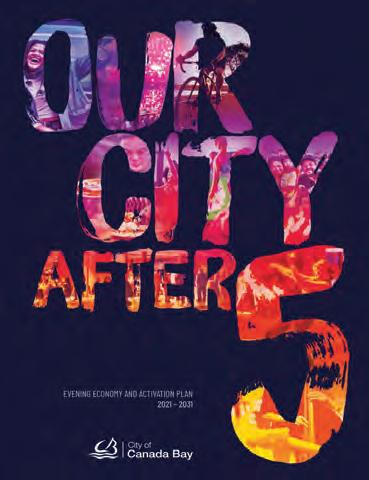
• Local Approvals Policy
• Community Engagement Policy

• Community Events Policy
• Sustainable Event Management Policy
• Business Use of Public Footpath Policy
• Various Place Plans
• Various Masterplans
• Local Strategic Planning Statement
• Local Environmental Plan
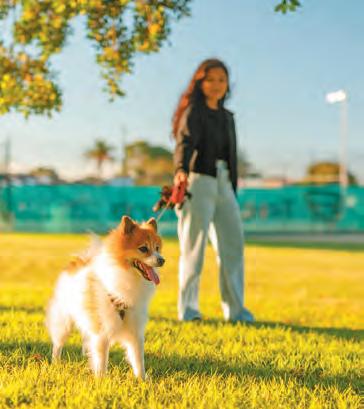
• Development Control Plan
Given the rapidly changing fabric of society with shifting work patterns due to the pandemic, the rise of digital intelligence both in the population and in program capabilities, the increased pressure on housing as population estimates increase and the impact of environmental changes, there is a need for a flexible, principle-based framework for looking after and improving our spaces.
As needs change so too does Place Management. This Framework allows for this change.
For enquiries or comment:
Place Management Team
City of Canada Bay Council
Tel: + 61 2 9911 6555
Email: council@canadabay.nsw.gov.au
Date of publication 21/06/23.
References: 1 Population forecast. Figures provided are approximate https://forecast. id.com.au/canada-bay/population-households-dwellings?SexKey=2&WebID=130&Yea r2=2031&AgeTypeKey=3

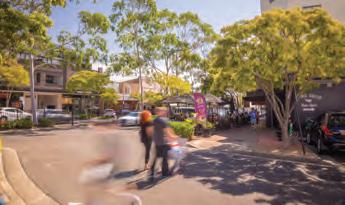
Majors Bay Road shopping village is an elegant, sophisticated and friendly shopping village in the heart of Concord.
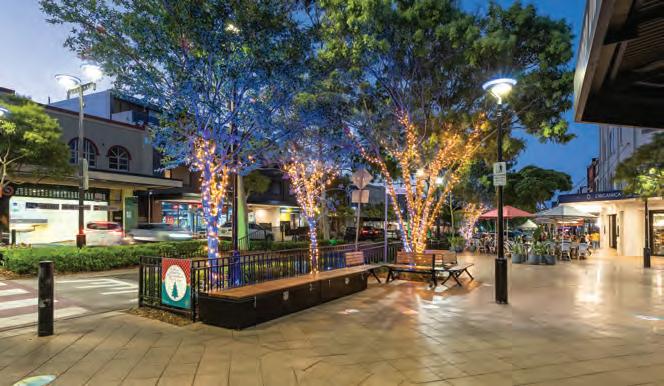

The business community, through the Majors Bay Chamber of Commerce, highlighted the need for an outdoor place for:
• Cultural and community activations
• The general community to gather
• To boost trade and attract people to the area.
Council consulted extensively and decided on closing Jellicoe Street at its junction with Majors Bay Road.
Parking was also highlighted as an issue and this was factored into the design, with additional parking spaces created.
The design was created in close association with the Chamber and surrounding businesses and residents. To test the space, Christmas Carols were held temporarily closing the road on 10 December 2019. Initial design concepts were shown at the event. Attendees suggested more public seats in clusters and options for shade. People also wanted a phone charging table. All these ideas were included in the final design. Research for the Place Plan showed people valued sustainability as well as heritage in the area thus trees were retained and introduced, bicycle racks installed as well as heritage artwork.

The results were celebrated at a launch event on 17 December 2020. It continues to be used actively by groups to this day. A big win with pop-up activations has been the on-site storage of furniture which also serves as a bench.
Time frame
Medium (2018 – 2020)
Catalyst
• Feedback from the business community
• Local residents suggesting more events and activations
• Political motivation to support the area
Consultation
• Resident surveys
• Community stakeholder meetings including Majors Bay Chamber of Commerce
• Two community workshops
• Christmas event
• Online polling of local and nearby residents and business owners
• Inter nal Council project group
Key partners
• Majors Bay Chamber of Commerce
• Local residents
• Local business
• KK Civil Engineering
• Transport and Urban Planning Consultancy
• Transport and Traffic Planning Associates
• NSW Gover nment – Transport for NSW
Budget spend
$600,000
Links
bit.ly/jellicoestreetpiazza
bit.ly/ccbpolicies
“Initially neighbours were sceptical, but now everyone has fabulous feedback. To be able to use the space for events and celebrations has been a great achievement and something that had been missing in our mainstreet for years.”
Marie Piccin Local ResidentAchievements
Community – working in collaboration with the Chamber not only assisted in a great design but they continue to invest time and resources to activate this space providing local leadership. In addition, they and surrounding businesses serve as a warning system when issues arise on the site.
Cultural – music and celebrations are now possible outside with local cultures showcased. In addition, the artwork created was so well loved the local supermarket used the same artist in their fitout.

Community – the site provides another location for people to connect, relax and engage.
$Economic – the site has provided a platform for activations, attracting people to the area and increasing trade. In turn this has created another avenue for our local cultural industry.
Built form – this project was delivered on time and within budget, a great achievement given it was built during a time of changing COVID-19 restrictions and supply issues.
Built form – this is the first site in the City to provide a device charging station, a good opportunity to implement part of our Smart Cities policy.

In 2018, Council asked the community to help us shape the 2019 Victoria Road Urban Design Review priorities. During this consultation, the community identified that they wanted public space to gather safely for events and outdoor dining because this would bring vitality and vibrancy to the commercial precinct.
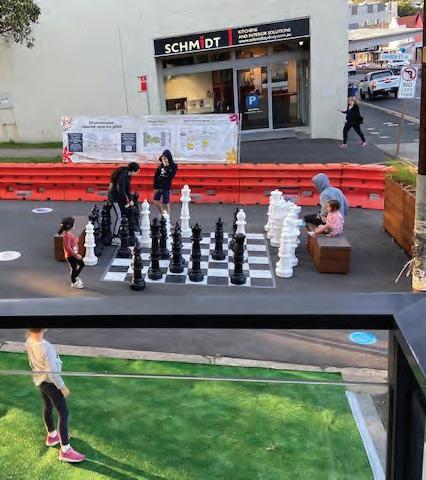

In November 2020, as a result of the COVID-19 pandemic, a new fund was launched by the State Government to create new open space and enhance high streets. The program aimed to support local businesses and improve the experience for the community. The Place Team rapidly established and implemented the program in partnership with local businesses and creatives.
• State Gover nment provided the funding,
• Council managed the street closure project and established an intensive activation program
• Support from businesses included provision of power, public toilets, security guards, art exhibitions and performers
• Council established night markets, music nights and play sessions in the spaces.

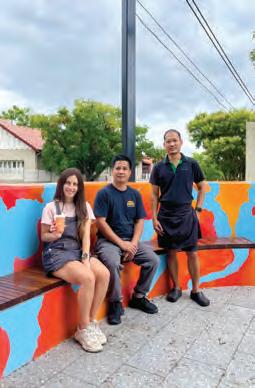
The long term results include:
• Two new permanent public spaces
• City-wide road closure trials to support public spaces in centres
• New entrepreneurs and businesses (e.g. Glaze Galleria)
• New professional performers.
The short term (9 month) project has become a permanent project.
Catalyst
The Drummoyne Urban Design Strategy identified:
• The need for more public space
• The opportunity road closures would create.
This planning tool enabled the Place Team to respond to this funding opportunity and deliver a community-led vision.
The NSW Government provided funding as part of the Streets as Shared Spaces Fund to pilot two temporary road closures in Drummoyne.
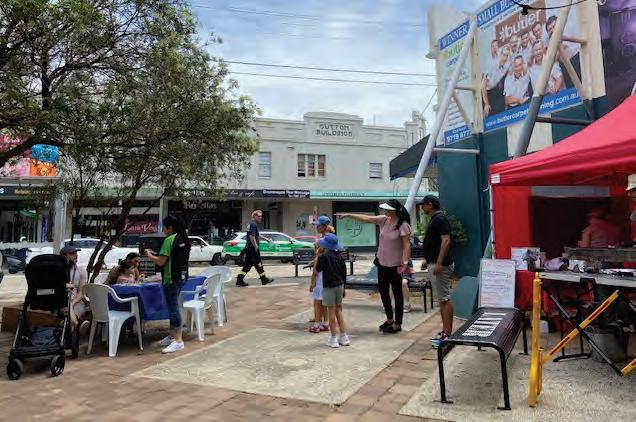
The pilot initially ran from 26 October–31 December 2020 and was subsequently extended until March 2021. This pilot involved the closure of a small section of Formosa Street at Lyons Road, and Church Street became one-way from Formosa Street to flow on to Victoria Road only.
Consultation
• Online survey
• Door knocking
• Intercept surveys
• Interviews
• Workshops
• Place audits
• Ethnographic observations
• People counting (digital and manual)
Key partners
• Laundy Hotels – space for gallery and activations, supplied electricity to site, site office provision of construction, and security guards provided
• Strata company
• Local artist and crafters
• State Gover nment
Built form – delivery of two shared spaces.
Identity – changing the narrative from car spaces to people places.
Community – Support for residents to lead the future of our town centre.
Social – number and quality of partnerships developed, local business support has been invaluable and stakeholder and resident satisfaction levels are high.
Cultural – supported over 30 artists including First Nations artists. Hosted buskers and markets.
Budget spend $3.3 million
Links bit.ly/VictoriaRoadUDR
“It is beneficial to local residents and businesses – customers always comment on how much nicer it is. It has made the intersections on either side of the area more safe.”
Pongsathorn Patanan, Thai La-Ong Drummoyne
Social isolation was highlighted as an issue in Chiswick. Council secured a Liveable Communities Grant from the NSW Government to run Chiswick Connects.

This program sought to:
1. Increase social cohesion in Chiswick and surrounds through a subsidised holistic activity program
2. Increase connections amongst isolated members of the Chiswick community and surrounds
3. Create intergenerational connection opportunities
4. Improve fitness and wellbeing in the community.
A range of activities were set up:
• Salsa classes
• Bootcamp
• Tai chi
• A food program to learn to cook healthy foods
• An intergenerational multimedia oral and pictorial history project
• Guitar classes
• An intergenerational art project.
Different service models were trialled. A new community group was set up to continue the cultural activities in the space once funding ceased. This group is operating successfully today.

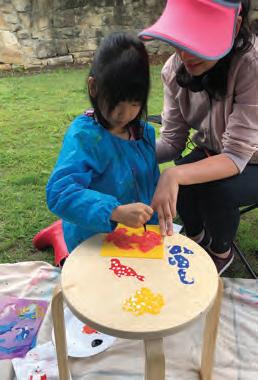

Chiswick Connects was part of the Place Plan which also saw improved transport and access, raised civic amenity, created new public art, and established historical and community gardens.
Time frame
Medium
Catalyst
• Feedback from the community
• Political motivation to connect the community
Consultation
• Resident surveys
• Community workshops
• Online forum
• Inter nal Council project group
Key partners
• Local Gover nment NSW
• NSW Gover nment – Family & Community Services
• Exter nal providers including Share, Salsa 4 Seniors, Volunteer and Particle
• Abbotsford Public School
• St Andrews Kindergarten
• Residents
• Business
Budget spend $78,984.95
(this includes a grant of over $47,000)
Links bit.ly/managingplaces
“Friendships have definitely formed and people have even told us that the Salsa 4 Seniors Program has brought joy back into their lives”.
Beatriz
Occhiuzzi,local teacher.
“I’m delighted to meet other people who are interested in the same lifestyle. Also, it’s wonderful that these workshops are building a community of like-minded people.”
Member of the Pickling and Preserving workshop.
Achievements
Social – 50% of the participants made new friends through this program which increased social cohesion. Anecdotally this figure was higher.
Community – participants were physically fitter and learnt new skills with 65% reporting they felt mentally fitter. Nearly 300 people took part in the programs.
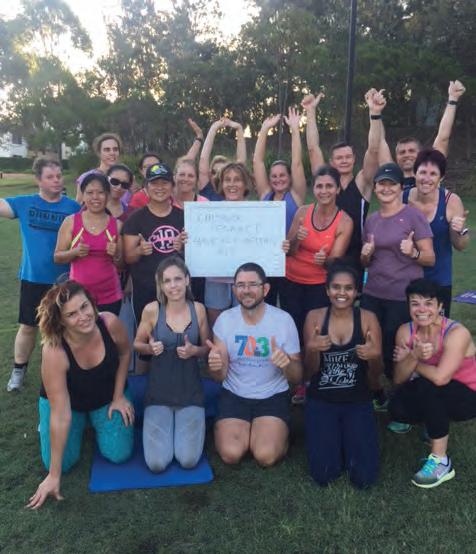
Community – capacity building with the creation of the Chiswick Community Activities Group by local residents.
Cultural – new artwork was created adding amenity to the Chiswick Community Centre, a multi-media history project created for the area, a new yearly Movies Under the Stars event started with the last session drawing a crowd of over 1,000 people. People also learnt photography skills. Salsa 4 Seniors was a big hit and continues to this day with a new art class added to the offerings.
$Economic – a new business was attracted to the area and bookings for the Chiswick Community Centre increased.
